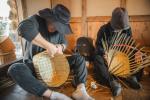- Songdang, Waheul and others hold village rites
 |
||
| The faithful at Songdang dae-je. Photo by Anne Hilty | ||
The shamanist rites of the (lunar) year have begun.
Jeju villages have traditionally held four annual great rites, and others according to need. The first of these, 'sin-gwa-se-je' or ritual to the god-spirits, also called 'dae-je' or great rite, occurs approximately two weeks after the lunar year begins, at or very near the first full moon. (Varying from village to village, it is nevertheless always held in the first month.)
In the mainland, this day is a traditional holiday referred to as 'dae-bo-reum' and while the objective – to obtain the gods' beneficence for the coming agrarian cycle of plant-and-harvest – is the same, the practices are quite different from those of Jeju.
Two of the most well-known and researched village sin-gwa-se-je are those held in Songdang and Waheul. Both attract a large number of researchers and media representatives, the latter – sponsored by the Ministry of Culture, Sports and Tourism and its related entity, Korean Traditional Performing Arts Foundation – especially so.
When some of the elder female devotees at Waheul, huddled around a small fire, were asked if the crowd of reporters and camera operators disturbed their genuine experience of the ritual, they replied in the affirmative but with resignation, stating, “But what can we do? They are our guests.”
The repeated requests by shamans and village leaders alike for reporters not to enter the area behind the altar, however, believed to be the pathway between shrine and spirit world, indicated a distinct lack of guest-like behavior.
These same disrespectful acts in the Songdang ritual were strongly controlled by the village women's leaders, two of whom played key roles in the day's events and were included in the shaman's blessing of village officials. In Waheul, an obviously Confucian-influenced village, the ritual included three presiding male village leaders while the women's leader was in charge of the food production only.
Songdang Village ritual was held on Friday, February 22, for which the presiding shaman – 'mein-simbang' – was Jung Tae-jin. The shrine is dedicated to the goddess Geum Baekjo, believed to be the mother of all Jeju shamanist gods, and she was invoked repeatedly in the bonpuri of the village, or oral history delivered as song. It is located on Dang Oreum, near the entrance; the original shrine, moved years ago, was located at the oreum's crest.
Geum Baekjo is a goddess of agriculture; divorcing her husband, Socheonguk, who was a hunter and as such represented the hunter-gatherer culture, she depicted the shift to farming and the idea of property, of settling down and building community, experienced by cultures around the world.
Songdang ritual is unique in that Jacheongbi, goddess of earth and giver of Jeju's six grains, is also invoked; some local folklorists believe that these two goddesses may have originally been the same, further correlated with Sekyoung Halmang or the Old Woman of Agriculture, although for each a distinctive myth has developed. In keeping with this agricultural theme, the ritual food served is 'maemil guksu' or buckwheat noodle soup laced with chicken.
The motif of grandmothers as keepers of the village religious traditions was obvious in the Songdang ritual; numerous elder women were seated against the stone wall of the shrine, three – likely 'sang-dan-gol' or highest [most devout] shrine tenders – seated in a prime spot near the altar itself, while younger women were gathered in the rear of the ritual space or busily preparing food, and men milled around outside the shrine area, tending fires.
In every ritual, following the calling of the spirits, acknowledgment of those in attendance and story of the village, request for the gods' beneficence, divination to ascertain the village's outlook for the coming year, and blessing of the village officials, there is a time for dancing. As the shaman sings and attendees respond, many join in the dance in a spirit of community and social cohesion.
In this year's Songdang ritual, during a break after the dancing, the assisting shaman who had led the dance cajoled the few male participants, lightly mocking their dancing ability. In a moment never to be repeated, this shaman, a woman in her 60s and in full regalia, then broke into the 'horse dance' from the wildly popular 'Gangnam-style' music video, to her audience's delight.
Though not as many as in Waheul, researchers and media representatives were in attendance at Songdang as well; however, they were kept separate from devotees and away from the altar. A boom was used by one broadcasting company to move its camera into the ritual but, although its presence was jarring, maintained enough distance to satisfy the shamans and devotees.
It is an interesting commentary on the struggle for balance between tradition and modernity, experienced in cultures the world over and at the present time in Jeju, that a number of attendees were witnessing the ritual through the lens of a camera – or smartphone.
The Waheul village rite took place on Saturday, February 23, facilitated by mein-simbang Kim Sun-ok. The Waheul bon-hyang-dang or village shrine is one of the most beautiful and well-established, including not one but two enormous spirit-trees, both approximately 400 years old. The shrine has been the subject of several documentaries and as a result, this rite attracts hoards of media who literally create a barrier between the pockets of villagers gathered around various small fires at the periphery, and the altar and delineated ritual space. A small group of devotees, likely 'sang-dan-gol', were the exception, tucked beneath one of the spirit-trees.
The patron deity of the Waheul shrine is the 11th son of Geum Baekjo, goddess of the Songdang shrine. The associated myth tells of the god's cursing of his wife because in her pregnancy, she craved and ate black pork which was forbidden; as a result, the Waheul shrine has a large main altar to the god and a small, distant altar in the east for the goddess.
Some local folklorists believe that the main shrine was originally dedicated to the goddess, wronged by her husband who cast her out unjustly, and whose mother, the mother of all Jeju shamanist gods, commanded him to treat his wife properly. It is thought that the supremacy of the male deity at the shrine is a distortion of the original myth, developed in the Confucian-oriented Joseon era.
When grandmothers at the Waheul ritual were asked about this arrangement, they explained that, during the village rites, both god and goddess are worshiped at the large altar; however, when devotees come to the shrine on their own, they worship at the small altar only – to the goddess.
“The goddess listens to our troubles,” they agreed, “but the god is not interested.”
Despite the strongly Confucian influence in this shamanist ritual, the shrine itself, though officially a bon-hyang-dang or village shrine, functions primarily as a 'halmang-dang' or goddess shrine for the villagers – the majority of which, just as in Songdang, are elder women.
The Waheul ritual was similar in form to that of Songdang with one notable exception: the shamans repeatedly brought the village leaders, three men in black Confucian-style robes, into the ritual, while the female village leader was not included.
Songdang and Waheul are not coastal but farmland villages, and include the sacrifice of a rooster late in the ceremony, following a period of divination for individual village members.
In both villages, the outlook for this lunar year is favorable.
–
Dr. Hilty is a cultural health psychologist from New York who now makes Jeju Island her home; she has been studying shamanism around the world for more than 25 years.
Anne Hilty eastwest.psyche@gmail.com
<저작권자 © 제주위클리 무단전재 및 재배포금지>






